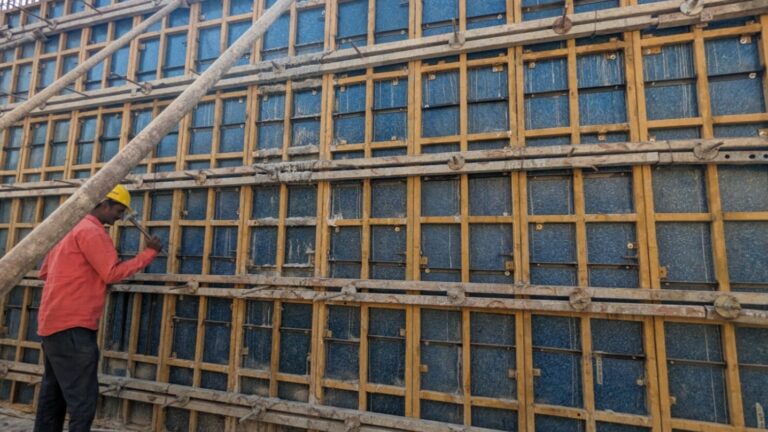Formwork is an essential element in the construction industry. It is the temporary mould into which concrete is poured to create structural components like walls, beams, and columns. Understanding the key techniques and best practices associated with formwork can significantly improve the efficiency, safety, and quality of construction projects. This blog will delve into these techniques and practices, emphasising the growing importance of modern materials like plastic formwork for construction.
Types of Formwork
Formwork can be categorised into several types based on the materials used:
- Timber Formwork: Traditionally used and still prevalent in small-scale projects. Timber formwork is easy to handle and shape but less durable than modern materials.
- Steel Formwork: Known for its strength and durability, steel formwork is ideal for large structures. It can be reused multiple times, making it cost-effective in the long run.
- Aluminium Formwork: Lightweight and strong, aluminium formwork is easy to handle and can be used for repetitive tasks, enhancing efficiency.
- Plastic Formwork: An emerging favourite in the industry, plastic formwork is durable and sustainable. It is particularly suitable for complex shapes and can be reused many times without significant wear and tear.
Key Techniques in Formwork
1. Proper Planning and Design
Effective formwork begins with thorough planning and design. Understanding the project requirements, load calculations, and the type of concrete mix to be used are crucial steps. The formwork must be designed to withstand the pressure exerted by the concrete and any additional loads during the pouring and curing process.
2. Selection of Materials
Choosing the suitable formwork material is critical. Modern projects increasingly turn to recycled plastic shuttering sheets and boards due to their durability and environmental benefits. These sustainable materials offer high strength and resistance to water and chemicals.
3. Assembly and Erection
Assembling formwork correctly is essential to ensure the structural integrity of the concrete. This involves accurate alignment, secure connections, and adequate support to prevent deformation under load. Techniques like pre-assembling formwork panels and modular systems can save time and improve precision.
4. Maintenance and Reuse
One of the best practices in formwork is regular maintenance to extend its lifespan. This is remarkably easier for recycled plastic shuttering boards, which can be reused multiple times if cared for. Cleaning and repairing formwork after each use helps maintain its structural integrity and performance.
5. Safety Measures
Ensuring the safety of workers is paramount in formwork construction. This includes providing proper training, using safety gear, and adhering to safety protocols. Regular inspections of the formwork during assembly and before pouring concrete can prevent accidents and ensure a safe working environment.
Best Practices for Formwork
1. Embrace Sustainability
Sustainable construction materials like plastic formwork benefit the environment and enhance the project’s efficiency and cost-effectiveness. Sustainable materials reduce waste, lower carbon emissions, and promote a circular economy.
2. Use Advanced Technologies
Leveraging modern technologies such as Building Information Modeling (BIM) can optimise formwork design and execution. BIM allows for precise planning, visualisation, and management of formwork, reducing errors and increasing productivity.
3. Optimize Formwork Systems
Choosing the right formwork system for your project can make a significant difference. Modular formwork systems, for instance, offer flexibility and ease of assembly, while prefabricated formwork panels can speed up the construction process.
4. Continuous Training and Development
Keeping up with the latest advancements in formwork technology and techniques is crucial. Regular training and development programs ensure workers are skilled and knowledgeable about formwork construction’s best practices and safety measures.
Recycled Plastic Formwork: The Best and Most Sustainable Choice
Recycled plastic formwork is the best and most sustainable choice for modern construction projects. These materials offer exceptional durability, are resistant to moisture and chemicals, and can be reused multiple times without significant wear. Builders can support recycling initiatives, reduce environmental impact, and promote a circular economy by opting for recycled plastic formwork. Using recycled materials not only conserves natural resources but also helps reduce greenhouse gas emissions associated with producing new materials.
Conclusion
The advantages of plastic shuttering for concrete are clear: durability, reusability, cost-effectiveness, and environmental benefits make it a superior choice for modern construction. Builders can enhance efficiency, reduce costs, and promote sustainability by incorporating plastic shuttering into their projects. This innovative material is set to play a pivotal role in the future of construction, driving the industry towards more sustainable and efficient practices.To learn more about Plastic Shuttering Boards, contact our experts at +91 78991 78777.

